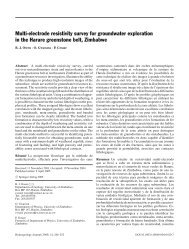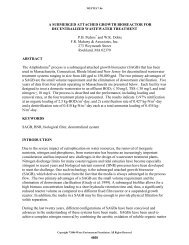Species diversity in the Florida Everglades, USA - Environmental ...
Species diversity in the Florida Everglades, USA - Environmental ...
Species diversity in the Florida Everglades, USA - Environmental ...
You also want an ePaper? Increase the reach of your titles
YUMPU automatically turns print PDFs into web optimized ePapers that Google loves.
Aquat. Sci. Vol. 68, 2006 Overview Article 267<br />
with ecological <strong>in</strong>tegrity, argu<strong>in</strong>g that <strong>the</strong> latter is <strong>the</strong> goal<br />
for which <strong>the</strong> former is a poor <strong>in</strong>dicator.<br />
To address <strong>the</strong> <strong>in</strong>formation limitations of species<br />
richness as an ecosystem <strong>in</strong>dicator, ecologists frequently<br />
turn to <strong>diversity</strong> <strong>in</strong>dices, derived orig<strong>in</strong>ally from <strong>in</strong>formation<br />
<strong>the</strong>ory. Such <strong>in</strong>dices, well known <strong>in</strong> <strong>the</strong> ecological<br />
literature, are adaptations of <strong>in</strong>formation <strong>the</strong>ory used to<br />
describe <strong>the</strong> organization of ecosystems which began<br />
with MacArthur (1955), who used <strong>the</strong> Shannon <strong>diversity</strong><br />
formulation (Eq. 1) to compare fl ows with<strong>in</strong> an ecosystem.<br />
The use of physical stocks (biomass, abundance,<br />
cover, frequency) of system actors as a metric of ecosystem<br />
condition began with Margalef (1961), and is now a<br />
standard component of ecological <strong>the</strong>ory and practice<br />
(Peet, 1974; Krebs, 2000). The typical formulation is:<br />
H = – j<br />
Σ<br />
i = 1 pi *log[pi] (1)<br />
where H is <strong>the</strong> <strong>diversity</strong>, pi is <strong>the</strong> probability of observ<strong>in</strong>g<br />
component i <strong>in</strong> a system of j components. Observation<br />
probabilities (pi) are typically measures of relative physical<br />
stocks for each ecosystem component. Ulanowicz<br />
(2001) suggests that <strong>the</strong> application of <strong>in</strong>formation <strong>the</strong>ory<br />
to ecosystems us<strong>in</strong>g Eq. 1 with physical stocks has met<br />
with mixed success; no consistent association between<br />
Shannon <strong>diversity</strong> and ecosystem function or stability<br />
has been demonstrated. As a result, some ecologists have<br />
tended to disregard <strong>the</strong> tools of <strong>in</strong>formation <strong>the</strong>ory for <strong>the</strong><br />
description of ecosystems (Ulanowicz, 2001).<br />
There are two limitations of conventional application<br />
of <strong>the</strong> Shannon <strong>diversity</strong> <strong>in</strong>dex that lead to its failure to<br />
effectively predict ecological properties (condition, stability,<br />
resilience, productivity). The fi rst is that <strong>the</strong> orig<strong>in</strong>al<br />
conceptualization of Shannon <strong>diversity</strong> was directed<br />
at <strong>the</strong> determ<strong>in</strong>acy of fl ows with<strong>in</strong> a system (MacArthur,<br />
1955), <strong>the</strong>oriz<strong>in</strong>g that <strong>the</strong> fl ows of energy and materials<br />
between components was <strong>in</strong>dicative of <strong>in</strong>formation transfer<br />
between components. Yet, subsequent applications of<br />
Shannon <strong>diversity</strong> replaced fl ows with physical stocks.<br />
The reasons and drawbacks for this convenient but unfortunate<br />
tangent are discussed <strong>in</strong> detail <strong>in</strong> Ulanowicz<br />
(2001).<br />
A second limitation of <strong>the</strong> standard Shannon <strong>diversity</strong><br />
metric is that it ignores ecosystem food web hierarchy.<br />
Given a fi xed number of ecosystem components, <strong>the</strong><br />
Shannon equation (Eq. 1) is maximized (Hmax) when <strong>the</strong><br />
probability of observ<strong>in</strong>g each component (pi) is equal;<br />
that is, evenness <strong>in</strong> physical stocks <strong>in</strong>creases <strong>diversity</strong>.<br />
However, given typical trophic transfer effi ciencies (i.e.,<br />
L<strong>in</strong>deman effi ciencies), and even differences <strong>in</strong> effi ciency<br />
between organisms with<strong>in</strong> <strong>the</strong> same trophic level, this<br />
benchmark of maximum ecosystem condition at maximum<br />
evenness <strong>in</strong> ecosystem physical stocks is erroneous.<br />
The result is that Shannon <strong>diversity</strong> us<strong>in</strong>g physical stocks<br />
is appropriate only with<strong>in</strong> a s<strong>in</strong>gle trophic level and can-<br />
not be used at <strong>the</strong> ecosystem scale or even with<strong>in</strong> groups<br />
(e.g., avifauna) populat<strong>in</strong>g multiple trophic levels. While<br />
we advocate <strong>the</strong> replacement of stocks with fl ows as per<br />
Macarthur’s (1955) orig<strong>in</strong>al <strong>in</strong>tent, a similar argument<br />
for comput<strong>in</strong>g <strong>diversity</strong> us<strong>in</strong>g physical fl ows (energy,<br />
carbon) can be made. That is, evenness of physical fl ows<br />
is not <strong>the</strong> expected condition for an entire food web because<br />
<strong>the</strong> energy/carbon throughput decreases geometrically<br />
with <strong>in</strong>creas<strong>in</strong>g trophic level.<br />
To address <strong>the</strong>se two limitations, we propose that a<br />
<strong>diversity</strong> <strong>in</strong>dex is necessary that: 1) accounts for <strong>the</strong> expected<br />
hierarchical distribution <strong>in</strong> <strong>the</strong> magnitudes of<br />
physical stocks across trophic levels and 2) accommodates<br />
<strong>the</strong> observed hierarchical distribution of fl ows <strong>in</strong><br />
ecosystem food web networks. In <strong>the</strong> follow<strong>in</strong>g sections<br />
we use energy systems <strong>the</strong>ory (Odum, 1994) to develop<br />
modifi cations of <strong>the</strong> Shannon <strong>diversity</strong> <strong>in</strong>dex that <strong>in</strong>corporate<br />
“quality adjusted fl ows” (defi ned below) to compute<br />
an ecosystem scale <strong>diversity</strong> <strong>in</strong>dex for <strong>the</strong> <strong>Everglades</strong>.<br />
An ecosystem application – <strong>the</strong> <strong>Florida</strong> <strong>Everglades</strong>. The<br />
<strong>Florida</strong> <strong>Everglades</strong> has been <strong>the</strong> focus of detailed ecological<br />
enumeration for many years, and data compiled<br />
for <strong>the</strong> Across Trophic Level Systems Simulation<br />
(ATLSS – DeAngelis et al., 1998) and matrix syn<strong>the</strong>sis<br />
provided by Ulanowicz et al. (2000 and 1997; http://<br />
cbl.umces.edu/%7eatlss/ATLSS.html) represent perhaps<br />
<strong>the</strong> most disaggregated and complete ecological network<br />
data available. Us<strong>in</strong>g carbon as <strong>the</strong> network numeraire,<br />
bilateral <strong>in</strong>teractions between system components (i.e.,<br />
species, groups of species or abiotic compartments) have<br />
been described us<strong>in</strong>g published data and fi eld measurements<br />
organized <strong>in</strong>to material fl ow <strong>in</strong>put/output matrices.<br />
Bilateral <strong>in</strong>teractions are defi ned as <strong>the</strong> allocation of<br />
available energy between biotic and abiotic compartments;<br />
cybernetic feedbacks are excluded from this defi -<br />
nition, a po<strong>in</strong>t we return to later. While fl ow matrices<br />
have been compiled for four ecosystem types <strong>in</strong> <strong>the</strong> <strong>Everglades</strong>,<br />
gram<strong>in</strong>oid marsh, cypress swamp, mangrove<br />
swamp, and <strong>Florida</strong> Bay, we focus on <strong>the</strong> gram<strong>in</strong>oid<br />
marsh <strong>in</strong> this study, employ<strong>in</strong>g <strong>the</strong> data presented <strong>in</strong> Heymans<br />
et al. (2002) and Ulanowicz et al. (2000), and <strong>in</strong>tegrat<strong>in</strong>g<br />
emergy <strong>the</strong>ory (Odum, 1996) with fl ow matrices<br />
to develop an ecosystem-scale measure of bio<strong>diversity</strong>.<br />
Emergy syn<strong>the</strong>sis and ecosystem networks. Network<br />
analysis, where a standard physical quantity (e.g., carbon,<br />
available energy) is used to describe bilateral <strong>in</strong>teractions,<br />
implicitly assumes that <strong>the</strong> energy <strong>in</strong> all those<br />
<strong>in</strong>teractions is directly comparable. Emergy <strong>the</strong>ory<br />
(Odum, 1994; Odum, 1996) suggests that this assumption<br />
is an ecological oversimplifi cation; different forms<br />
of energy have different qualities that refl ect <strong>the</strong>ir differential<br />
abilities to perform work with<strong>in</strong> an ecosystem. For
















